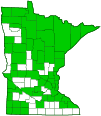Arabesque orbweaver
(Neoscona arabesca)
Conservation • Description • Habitat • Ecology • Distribution • Taxonomy
Conservation Status |
|||
| IUCN Red List | not listed |
||
| NatureServe | NNR - Unranked |
||
| Minnesota | not listed |
||
Description |
There are 123 spotted orbweaver species (genus Neoscona) worldwide. They are among the most common and abundant orb weaver spiders worldwide, and are among the most common of all spiders in North America. Only 8 species occur in North America north of Mexico. Of these, arabesque orbweaver is the most common. It is also one of the most common of all orb weaver spiders. Arabesque orbweaver is a small, spotted orbweaver. It occurs throughout North America and in Central America. It is most common in the United States east of the Great Plains. It is common in Minnesota. It is found in forests, fields, and meadows in tall grasses and on low bushes, and on buildings. The female can be 3⁄16″ to ½″ (5.2 to 12.3 mm) in length with a 11⁄16″ to 13⁄16″ (18 to 30 mm) legspan, but is usually less than 5⁄16″ (8.2 mm) in length. The male is slightly smaller, ⅛″ to ⅜″ (4.2 to 9.2 mm) long. The front part of the body (cephalothorax) is much smaller than the abdomen. The upper side (carapace) has a longitudinal furrow in the middle. The color may be yellow, orangish-yellow, or brown. There is a brown stripe in the middle and another near each lateral margin. There are eight eyes arranged in two parallel rows of four eyes each. The rear row is curved forward, the front row is straight or slightly curved backward. All of the eyes are small, but the median eyes are larger than the lateral eyes, and the posterior median eyes (PME) are slightly smaller than the anterior median eyes (AME). On each side the lateral eyes are widely separated from the middle (median) eyes and are almost touching each other. The median ocular area (MOA), the area defined by the middle four eyes, is longer than wide and narrower in front than behind. The abdomen is large, oval, rounded, and higher toward the rear. There are no low rounded humps (tubercles) in the shoulder (humeral) area. The color and pattern on the upper side is highly variable. It is most often mottled brown or brown and red with white and yellow markings. There is an irregular, triangular, forward pointing patch at the base that is often separated in the middle into two oblique spots. Behind this is a similar smaller but wider patch. Behind the second patch there is a narrow white band that extends to the rear of the abdomen. This line is sometimes split by a thin dark line, sometimes broken into distinct spots. On the rear half of the abdomen there are four pairs of dark oblique lines. The lines are sometimes partially surrounded by a white patch. The pattern of spots and lines on the abdomen is arabesque-like. This is the feature that gives the spider the first part of its common name. Occasionally, some or most of these markings are obscure or missing. The underside of the abdomen is black and is bordered on the sides with white spots. The legs are spiny and pale, with dark bands on the third and fourth pairs. The first pair of legs is the longest, the third pair is the shortest. The fifth segment (tibia) of the second pair of legs has a large number of conspicuous hairs on the lower surface. The male is distinguished by the following differences on the legs. The first segment (coxa) on the front pair of legs has a spur on the underside. The third segment (femur) on the second pair of legs has a groove on the upper side. There are spines on the underside of The femurs on the second, third, and fourth pairs of legs, but none on the first pair. The tibiae on the second pair of legs is curved; the outer lateral surface has several spines on the first half and just a single row of long stout spines on the second half; and the underside has only a few spines. |
Size |
Female Body Length: 3⁄16″ to ½″ (5.2 to 12.3 mm) Male Body Length: ⅛″ to ⅜″ (4.2 to 9.2 mm) Legspan: 11⁄16″ to 13⁄16″ (18 to 30 mm) |
Web |
A 6″ to 18″ (15 to 45 cm) in diameter hunting web is constructed in tall grass, on a low shrub, or on a building. It is called an “orb”, which gives this family of spiders its common name. The orb is vertical and has 18 to 20 radii. The center (hub) is open and is crossed with only 1 or 2 threads. A retreat is constructed at one side of the web consisting of a leaf folded over and secured with silk threads. |
Similar Species |
Habitat |
Forests, fields, meadows and buildings |
Ecology |
Season |
One generation per year: June to November |
Behavior |
The spider spends the day in the retreat and hunts at night. When hunting, it sits in the center of the web with the tip of its abdomen pushed through an open space in the hub. |
Life Cycle |
|
Food |
|
Distribution |
||
|
Sources |
|
| 8/27/2025 | ||
Occurrence |
||
Common |
||
Taxonomy |
|
Class |
Arachnida (arachnids) |
Order |
|
Suborder |
Araneomorphae (typical spiders) |
Infraorder |
Entelegynae |
Superfamily |
Araneoidea (orbweavers and allies) |
Family |
|
Subfamily |
Araneinae (typical orbweavers) |
Genus |
Neoscona (spotted orbweavers) |
Subordinate Taxa |
|
|
|
Synonyms |
|
Araneus arabesca Araneus minimus Araneus singularis Epeira arabesca Epeira singularis Epeira trivittata Neoscona minima |
|
Common Names |
|
arabesque orbweaver |
|
Glossary
Carapace
The hard, upper (dorsal), shell-like covering (exoskeleton) of the body or at least the thorax of many arthropods and of turtles and tortoises. On crustaceans, it covers the cephalothorax. On spiders, the top of the cephalothorax made from a series of fused sclerites.
Cephalothorax
The front part of a spider’s body, composed of the head region and the thoracic area fused together. Eyes, legs, and antennae are attached to this part.
Femur
On insects and arachnids, the third, largest, most robust segment of the leg, coming immediately before the tibia. On humans, the thigh bone.
Tibia
The fourth segment of an insect leg, after the femur and before the tarsus (foot). The fifth segment of a spider leg or palp. Plural: tibiae.
Visitor Photos |
Share your photo of this arachnid. |
||
This button not working for you? |
||
Anthony Hertzel |
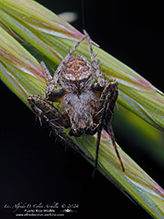 |
Alfredo Colon |
||
 |
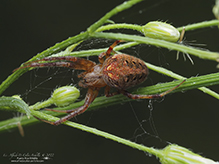 |
|
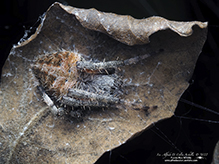 |
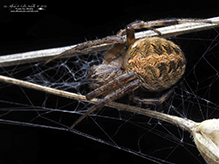 |
|
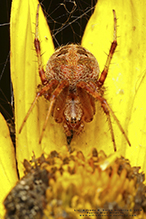 |
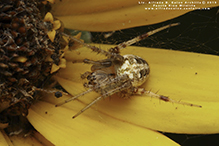 |
|
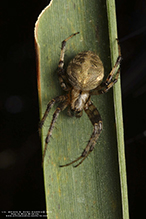 |
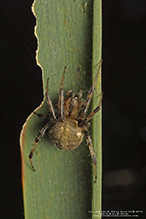 |
|
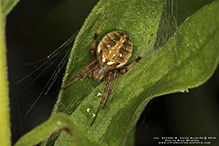 |
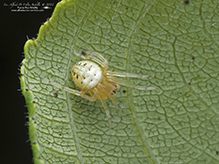 |
|
Mike Poeppe |
||
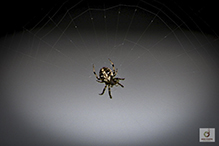 |
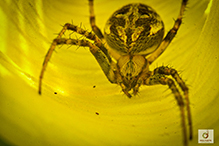 |
|
Babette Kis |
||
Neoscona arabesca arabesque orbweaver |
||
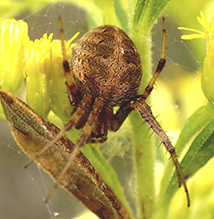 |
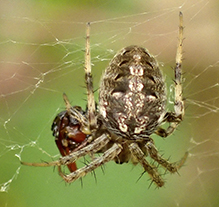 |
|
MinnesotaSeasons.com Photos |
|

Slideshows |
|

Visitor Videos |
Share your video of this arachnid. |
||
This button not working for you? |
||
|
Other Videos |
Orb Weaver Spider Neoscona arabesca Sutton Massachusetts |
About
Sep 8, 2009 This orb weaver spider, Neoscona arabesca, is spinning a spiral web in Sutton Massachusetts. The first half of the video shows the spider diligently working on its spider web. The second half shows the orb weaver preparing a caterpillar that somehow was gently flung into its web as a snack. For more local animal photos and videos visit https://SuttonMass.org Sutton is located in south central Massachusetts. Massachusetts is located in the northeastern corner of the United States. |
Neoscona arabesca |
About
Nov 5, 2021 this is another kind of spider known as Neoscona arabesca. for further details https://en.m.wikipedia.org/wiki/Neoscona_arabesca |
Neoscona arabesca spider is sleeping on the tip of the plant |
About
Sep 26, 2021 Neoscona arabesca spider is sleeping on the tip of the plant #lboard #spider #jumpingspider |

Visitor Sightings |
Report a sighting of this arachnid. |
||
This button not working for you? |
||
Anthony Hertzel |
Location: North of Grand Marais along a wooded corridor of Lake Superior |
 |
| Mike Poeppe 7/31/2024 |
Location: near Houston, MN |
 |
| Alfredo Colon 6/10/2024 |
Location: Albany, NY |
 |
| Mike Poeppe 9/20/2023 |
Location: Houston, MN |
 |
| Alfredo Colon 8/10/2022 |
Location: Albany, NY |
 |
| Alfredo Colon 8/3/2022 |
Location: Albany, NY |
 |
| Babette Kis 9/2/2021 |
Location: Barnes Prairie, Racine Co., WI |
 |
| Alfredo Colon 8/14/2019 |
Location: Woodbury, MN |
 |
| Alfredo Colon 8/12/2019 |
Location: Woodbury, MN |
 |
| Alfredo Colon 8/10/2019 |
Location: Woodbury, MN |
 |
| Alfredo Colon 8/4/2019 |
Location: Woodbury, MN |
 |
MinnesotaSeasons.com Sightings |
|

|
Created: 1/3/2022 Last Updated: © MinnesotaSeasons.com. All rights reserved. |
